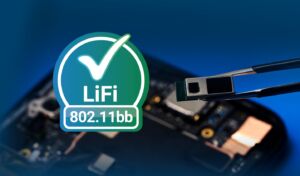
Light is almost certainly the fastest thing around. So it makes sense that "light-based wireless communications," or LiFi, could blow the theoretical doors off existing radio-wave wireless standards, to the tune of a maximum 224GB per second. [Edit, 2:40 p.m.: It does not make sense, and those doors would remain on each rhetorical vehicle. As pointed out by commenters, radio waves, in a vacuum, would reasonably be expected to travel at the same speed as light. Ars, but moreso the author personally, regrets the error. Original post continues.]
So long as there's nothing blocking the space between your receiver and the lightbulb you've fashioned into a LiFi access point. Or you don't need to turn the bulb off entirely to sleep. And you're willing to add a dongle and keep it pointed the right way, at least for the moment.
But LiFi, or 802.11bb, isn't really meant to replace Wi-Fi, but complement it—a good thing for a technology theoretically nullified by a sheet of printer paper. In an announcement of the standard's certification by IEEE (spotted on PC Gamer) and on LiFiCO's FAQ page, the LED-based wireless standard is pitched as an alternative for certain use cases. LiFi could be useful when radio frequencies are inhibited or banned, when the security of the connection is paramount, or just whenever you want speed-of-light transfer at the cost of line-of-sight alignment.
Frauenhofer HHI, one of the standard's developers, suggests "classrooms, medical, and industrial scenarios." Operating in the optical spectrum, rather than the limited amount of licensed radio wavelengths, "ensures higher reliability and lower latency and jitter," says Dominic Schulz, lead LiFi developer at Frauenhofer. It also reduces jamming and eavesdropping and enables "centimeter-precision indoor navigation."

Now that it exists as a published standard, how does LiFi exist as an actual product you can use? In very limited fashion. If you like bleeding-edge networking technology, you can get into LiFi for $2,200 with the LiFiMax Flex, a kit that is "the most affordable LiFi product on the market today," according to LiFiCo. For that price, you get a ceiling-mounted access point and antenna, a dongle, and RJ45 cable to run to your connection. If you had $200 more to spend, you could add in a LiFiMax Tab, a tablet in a ruggedized case that does not require a dongle to access LiFi (though, graciously, it also has traditional Wi-Fi connectivity).
Curiously, these packages only promise 150Mbps down and 140Mbps up. PureLiFi, designing products for original equipment manufacturers, promises that its Light Antenna One is "gigabit capable," while a product brief describes it as "1 Gbps +." The product page suggests that LiFi is the "pathway to breakneck speeds," but where we are on the trail right now isn't any wider than traditional Wi-Fi's broadest points.
There is potential here, despite the early Wi-Fi-via-flashlight awkwardness. While you can't turn a LiFi point entirely off, the signal has integrity at 10 percent room illumination (60 lux), and LiFiCo's FAQ suggests future use of the invisible parts of the light spectrum. LiFi also, crucially, works as an actual light source. The current fluctuations inside the light, which transmit the binary data, are happening at speeds so fast that the human eye can't perceive them. LiFi should not, in other words, remind you at times why "dimmable" bulbs are important.
And an ultra-high-speed, sight-line-required connection could make sense for emerging applications like AR/VR/XR, peer-to-peer transfer in a secure setting, or simply offloading a bandwidth-eating process from a taxed Wi-Fi network.
While newer Wi-Fi standards and copper lines can seemingly handle most of our bandwidth needs, demand tends to grow in volume to the size of its container. LiFi could be that next container. So long as your cat doesn't walk over it.
Reader Comments (209)
View comments on forumLoading comments...